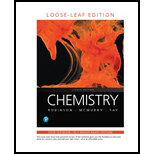
Concept explainers
(a)
Interpretation: A balanced net ionic equation for the reaction of Mn with dilute sulfuric acid in the absence of air needs to be determined.
Concept Introduction : Ionic equation is a chemical equation, where the electrolytes in aqueous solution are expressed as dissociated ions or in their ionic form.
(b)
Interpretation: A balanced net ionic equation for the reaction of Ag with dilute sulfuric acid in the absence of air needs to be determined.
Concept Introduction : Ionic equation is a chemical equation, where the electrolytes in aqueous solution are expressed as dissociated ions or in their ionic form.
(c)
Interpretation: A balanced net ionic equation for the reaction of Sc with dilute sulfuric acid in the absence of air needs to be determined.
Concept Introduction : Ionic equation is a chemical equation, where the electrolytes in aqueous solution are expressed as dissociated ions. Usually, this is often a salt dissolved in water, wherever the ionic species are followed by (aq) within the equation to indicate they're in solution.
(d)
Interpretation: A balanced net ionic equation for the reaction of Ni with dilute sulfuric acid in the absence of air needs to be determined.
Concept introduction:
Ionic Equation is a chemical equation, where the electrolytes in aqueous solution are expressed as dissociated ions. Usually, this is often a salt dissolved in water, wherever the ionic species are followed by (aq.) within the equation to indicate they're in solution.
Want to see the full answer?
Check out a sample textbook solution
Chapter 21 Solutions
Chemistry, Loose-leaf Edition (8th Edition)
- What is the reactant that makes the following product of the reaction? Please provide a detailed explanation and a drawing to show how the reaction proceeds.arrow_forwardDraw the products formed when each ester is hydrolyzed with water and sulfuric acid.arrow_forwardDraw the complete structural formula from each condensed structure. include all hydrogen atoms.arrow_forward
- Draw the complete structural formula from each condensed structure. Include all hydrogen atoms.arrow_forwardIndicate how H2O2 intervenes in the synthesis of K4[Co2(C2O4)4(OH)2]. Write the reactions.arrow_forwardExplain how, based on physical gas adsorption isotherms, we can determine whether multi-walled C nanotubes are open at their ends. Explain this.arrow_forward
- can somone answer pleasearrow_forwardConstruct a molecular orbital energy-level diagram for BeH2. Sketch the MO pictures (schematic representation) for the HOMO and LUMO of BeH2 [Orbital Potential Energies, H (1s): -13.6 eV; Be (2s): -9.3 eV, Be (2p): -6.0 eV]arrow_forwardIndicate the isomers of the A(H2O)6Cl3 complex. State the type of isomerism they exhibit and explain it briefly.arrow_forward
- State the formula of the compound potassium μ-dihydroxydicobaltate (III) tetraoxalate.arrow_forwardConsider the reaction of the cyclopentanone derivative shown below. i) NaOCH2CH3 CH3CH2OH, 25°C ii) CH3!arrow_forwardWhat constitutes a 'reference material', and why does its utilization play a critical role in the chemical analysis of food products? Provide examples.arrow_forward
 Chemistry: The Molecular ScienceChemistryISBN:9781285199047Author:John W. Moore, Conrad L. StanitskiPublisher:Cengage Learning
Chemistry: The Molecular ScienceChemistryISBN:9781285199047Author:John W. Moore, Conrad L. StanitskiPublisher:Cengage Learning Chemistry by OpenStax (2015-05-04)ChemistryISBN:9781938168390Author:Klaus Theopold, Richard H Langley, Paul Flowers, William R. Robinson, Mark BlaserPublisher:OpenStax
Chemistry by OpenStax (2015-05-04)ChemistryISBN:9781938168390Author:Klaus Theopold, Richard H Langley, Paul Flowers, William R. Robinson, Mark BlaserPublisher:OpenStax ChemistryChemistryISBN:9781305957404Author:Steven S. Zumdahl, Susan A. Zumdahl, Donald J. DeCostePublisher:Cengage Learning
ChemistryChemistryISBN:9781305957404Author:Steven S. Zumdahl, Susan A. Zumdahl, Donald J. DeCostePublisher:Cengage Learning Chemistry: An Atoms First ApproachChemistryISBN:9781305079243Author:Steven S. Zumdahl, Susan A. ZumdahlPublisher:Cengage Learning
Chemistry: An Atoms First ApproachChemistryISBN:9781305079243Author:Steven S. Zumdahl, Susan A. ZumdahlPublisher:Cengage Learning
 Chemistry & Chemical ReactivityChemistryISBN:9781337399074Author:John C. Kotz, Paul M. Treichel, John Townsend, David TreichelPublisher:Cengage Learning
Chemistry & Chemical ReactivityChemistryISBN:9781337399074Author:John C. Kotz, Paul M. Treichel, John Townsend, David TreichelPublisher:Cengage Learning





